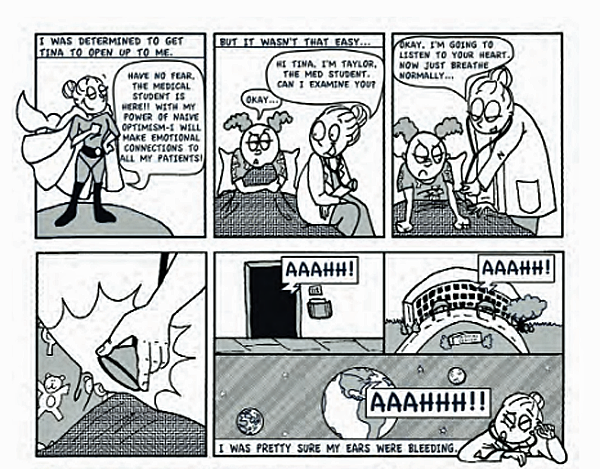With comics, students expose a dark side of medical education
Listen
A portion of the comic 'Perspective' by Trey Banbury (Image courtesy of Banbury)
An unusual humanities course at Penn State Medical School is revealing a problem common to many schools: mistreatment by senior physicians.
In the class, Comics in Medicine, students study graphic novels with medical themes, then are assigned to create their own strips based on their days as trainees. It’s a chance, said course instructor Michael Green, for the near-physicians to reflect on what they’ve learned and express themselves. And, he said, “it’s fun.”
But over six years Green has noticed a disturbing trend. Nearly half of his students use some type of horror imagery to describe their experience in med school.
“A lot of times they’re using these monster images to portray people who ostensibly are their teachers and mentors,” he said.
In one case, a student depicted his adviser as a devil with horns. In another, there’s a decapitation. A slew of others include sleep-deprived zombies or ghosts illustrating loneliness and depression.
Not all the comics are so dark. Many students relate stories of triumph — times when they’ve been able to finally grasp the complexities of a surgical procedure, for instance, or made a meaningful connection with a patient.

A portion of the comic ‘The Taming of Tina’ by Taylor Olmsted (Image courtesy of Olmsted)
But Green said in reviewing the comics, the widespread use of horror elements was striking. In his analysis of the art, published in the journal JAMA last week, he noted that these grim stories are visceral reminders of a real problem. In a recent survey, nearly 40 percent of medical students said they’d experienced abuse at the hands of their teachers. And about half of doctors regularly report symptoms of burnout.

A portion of the comic ‘Whatever Floats Your Boat’ by Shane Lavin (Image courtesy of Lavin)
The comics, rife with visual metaphors, just make the emotions and feelings surrounding the issue more immediate and harder to ignore, said Green. Take, for example, one strip in which an attending physician sports horns and a pointed tail and yells at a trainee.
“Sequentially you see the student shrink in stature from a normal-sized person down to a tiny little mouselike character,” said Green. “The student was expressing how it felt to be belittled by showing himself becoming smaller.”
For Trey Banbury, a bloody beheading was just one of the graphic elements used to portray his struggle with a superior in his 2013 comic, “Perspective.” But, he said, the point of his comic was not to demonize her.
“She was miserable to be around, but that misery was compounded by my own negative expectations,” said Banbury, who is now doing his residency in anesthesiology at the Cleveland Clinic. “Seeing her in a vulnerable state offered needed perspective, effectively ‘killing’ the monster.”
On the last page, after Banbury has overheard her sobbing, her horns melt away.

A portion of the comic ‘The Test Cycle’ by Alex Burton (Image courtesy of Burton)

A portion of the comic ‘Culture of Compassion’ by Jenny Rice (Image courtesy of Rice)
WHYY is your source for fact-based, in-depth journalism and information. As a nonprofit organization, we rely on financial support from readers like you. Please give today.

